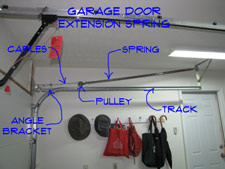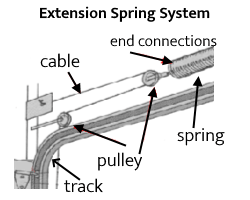Are you wondering how to balance a garage door with extension springs? You’ve come to the right place! Balancing your garage door is essential for proper functioning and longevity, and in this article, we’ll walk you through the steps to achieve that perfect balance.
No worries, it’s not as complicated as it might sound. We’ll break down the process into simple, easy-to-follow steps that anyone can do. By the end, you’ll have the confidence and know-how to ensure your garage door operates smoothly and safely.
So, let’s dive in and learn how to balance your garage door with extension springs, ensuring it opens and closes with ease, and keeps your belongings protected. Ready to get started? Let’s go!
1. Start by disconnecting the garage door opener.
2. Slide a winding bar into the bottom hole of the winding cone.
3. Hold the bar securely and slowly lift the door until it reaches the desired height.
4. Insert another winding bar into the next hole of the winding cone and repeat step 3.
5. Continue this process until the door is properly balanced.
6. Finally, reconnect the garage door opener and test the balance.
Remember to exercise caution and seek professional help if needed.

How to Balance a Garage Door with Extension Springs: A Comprehensive Guide
Welcome to our comprehensive guide on how to balance a garage door with extension springs! A properly balanced garage door not only ensures smooth and efficient operation but also extends the lifespan of your door and its components. In this article, we will walk you through the step-by-step process of balancing a garage door with extension springs, highlighting the importance of balance, the tools you’ll need, and helpful tips to make the task easier. Let’s dive in!
Understanding the Role of Extension Springs in Garage Doors
Before we dive into the process of balancing a garage door with extension springs, it’s important to understand the role these springs play in the overall functioning of the door. Extension springs are responsible for counterbalancing the weight of the garage door, making it easier to open and close. When the door is properly balanced, the weight is evenly distributed, reducing strain and wear on the door opener and other components. It’s crucial to maintain the correct tension in the extension springs to ensure optimal performance and prevent potential safety hazards.
To determine if your garage door is properly balanced, you can perform a simple test. Disconnect the opener by pulling the release handle and manually open the door halfway. If it stays in place, it’s likely properly balanced; if it starts to fall or rises, it indicates an imbalance that needs to be addressed. Now that you understand the importance of balance let’s move on to the steps involved in balancing a garage door with extension springs.
Gathering the Necessary Tools and Equipment
Before you begin the process of balancing your garage door with extension springs, it’s important to gather all the necessary tools and equipment. Here’s a list of items you’ll need:
- Adjustable wrench
- Safety glasses
- Extension ladder
- Stepladder
- Tape measure
- Spray lubricant
- Pry bar
- Level
Having these tools on hand will make the balancing process much easier and efficient.
Step 1: Prepare the Garage Door
The first step in balancing a garage door with extension springs is to prepare the door for adjustment. Start by disconnecting the opener to ensure it doesn’t interfere with the process. Then, place a ladder on one side of the door, ensuring it’s stable and secure. If necessary, use a stool or additional support to reach the springs.
Next, visually inspect the extension springs and other components for any signs of damage or wear. Look for stretched or frayed springs, loose cables, or misaligned tracks. If you notice any issues, it’s recommended to consult a professional for repairs before attempting to balance the door.
After inspecting the springs, apply a spray lubricant to the torsion spring and other moving parts to ensure smooth operation. Lubricating the springs will reduce friction and help you make more accurate adjustments.
Step 2: Adjusting the Tension of the Extension Springs
Now that the door is prepped and you have the necessary tools, it’s time to adjust the tension of the extension springs. Start by locating the adjustment dial or screw on the spring. This mechanism allows you to increase or decrease the tension in the spring.
Using an adjustable wrench, turn the adjustment dial or screw in small increments. The general rule of thumb is to turn the dial or screw clockwise to increase tension and counterclockwise to decrease tension. Make small adjustments and periodically test the balance of the door. It’s important to achieve the right balance, so don’t rush through this process.
Keep in mind that a properly balanced garage door should be able to stay open at any height without falling or rising. If you notice the door is still unbalanced after making adjustments, it may be necessary to consult a professional for further assistance.
Step 3: Testing and Fine-Tuning
Once you’ve made the necessary adjustments to the tension of the extension springs, it’s time to test the balance of the door and fine-tune as needed. Reconnect the opener and operate the door using both the opener and manual methods. Pay attention to any signs of resistance, jerking, or uneven movement. Ideally, the door should move smoothly and effortlessly.
If you notice any issues, such as the door being too heavy to lift manually or the opener struggling to open or close the door, it’s likely that the balance is still off. In this case, revisit the adjustment dial or screw and make additional small adjustments until you achieve a smooth and balanced operation.
Remember, balancing a garage door with extension springs can be a delicate process, so it’s important to have patience and take your time to get it right. If you’re uncomfortable performing this task yourself, it’s always recommended to consult a professional garage door technician.
Key Takeaways: How to Balance a Garage Door with Extension Springs
- 1. Start by disconnecting the garage door opener from the door.
- 2. Identify if the springs are properly balanced by manually opening and closing the door.
- 3. Adjust the tension in the extension springs using a winding cone tool.
- 4. Make small adjustments and test the balance after each adjustment.
- 5. Repeat the process until the door remains balanced at any position.
Frequently Asked Questions
Welcome to our frequently asked questions section on how to balance a garage door with extension springs. Below, you’ll find answers to common queries related to this topic. Whether you’re a seasoned DIY-er or a curious homeowner, we’ve got you covered!
1. What are extension springs in a garage door?
Extension springs are the type of springs commonly used in residential garage doors. They work by extending and contracting to support the weight of the door, enabling it to open and close smoothly. Extension springs are typically found on either side of the garage door, parallel to the horizontal tracks.
These springs are stretched when the garage door is closed and store energy. When you open the door, the stored energy is released, providing the necessary force to lift the door. Balancing the garage door with extension springs ensures that the door operates safely and effectively.
2. How do I know if my garage door with extension springs is unbalanced?
An unbalanced garage door can be identified by certain signs. If your door is difficult to open or close manually, feels heavy, or slams shut forcefully, it may be unbalanced. Another indication is if the door is unevenly positioned when in the closed position, with one side higher than the other.
You can also perform a simple test by disconnecting your garage door opener and manually lifting the door halfway. If it stays in place without assistance, it is properly balanced. However, if it either rises or falls on its own, there is an imbalance that needs to be addressed.
3. Can I balance a garage door with extension springs by myself?
While it is possible to balance a garage door with extension springs on your own, it is recommended to seek professional assistance, especially if you’re not experienced with garage door maintenance. Balancing a garage door requires adjusting the tension of the springs, which can be dangerous if not done correctly.
Professional technicians have the expertise and knowledge to safely balance the garage door, ensuring it operates smoothly and reduces the risk of accidents. Their experience allows them to identify any underlying issues that may affect the door’s performance and address them accordingly.
4. How often do I need to balance my garage door with extension springs?
It is recommended to balance your garage door with extension springs at least once a year. However, if you notice any signs of imbalance, such as difficulty in opening or closing, it’s important to address the issue promptly.
Regular maintenance and inspection of the springs, including lubrication and adjustment if necessary, can help prevent imbalances and prolong the lifespan of the springs and the overall functionality of the door.
5. What are the benefits of balancing my garage door with extension springs?
Properly balancing your garage door with extension springs offers several benefits. Firstly, it ensures smooth and efficient door operation, reducing strain on the opener and other components. This can prolong their lifespan and minimize the need for costly repairs.
Additionally, balanced garage doors are safer to operate, minimizing the risk of accidents or injuries. They also provide better security for your home, as a properly balanced door is more difficult to forcibly open. Lastly, a balanced door improves energy efficiency by preventing drafts and maintaining a tighter seal, keeping your garage insulated.

Summary
Balancing a garage door with extension springs is important for its proper functioning and safety. To do this, you need to adjust the tension on the springs using winding bars. Start by closing the door, disconnecting the opener, and marking the position of the cables. Then, release the tension on the springs, make the necessary adjustments, and test the balance of the door. Remember, if you’re unsure or uncomfortable doing this yourself, it’s best to hire a professional to help ensure the job is done safely and correctly.
Regular maintenance is crucial to keep your garage door working smoothly. Inspect the springs for signs of wear or damage, and lubricate all moving parts regularly. By taking care of your garage door and keeping it properly balanced, you can extend its lifespan and avoid potential accidents.

